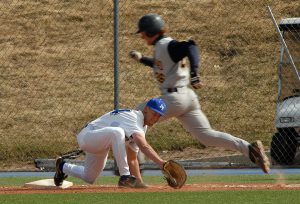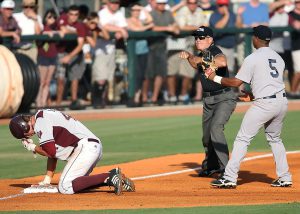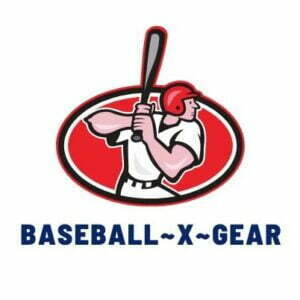Well Jeremy, exactly what is an out in baseball?
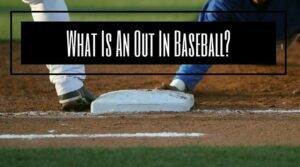 Howdy friends and welcome back!
Howdy friends and welcome back!
In today’s post we will be explaining what an out is and going through a few scenarios in which an out is recorded.
If you have been around the game for a while, you most likely already know what an out is.
But for those new to the game, an “out” in baseball may be something new.
As I continue to field questions about our beloved game, I have been enjoying sharing the ins and outs with you all.
I am starting to think of our recent posts as our “Baseball 101” series. I hope you have enjoyed reading them as much as I have enjoyed putting them together.
Remember that if you have any questions, topics, or rules that you would like to discuss, you can leave a comment at the end of any post and I will be more than happy to talk some baseball with you.
Don’t forget to check out Simple Baseball Rules for most of the basic rules of the game that will give you a good understanding of how the game is played. You can also scroll through the blog roll or type your question in the search box above to see if your question has already been answered.
So without further ado, let’s answer the question, What is an out in baseball?
What Is An Out In Baseball?
Instead of giving the same old standard definition of an out, I thought I would try to put it in my own words to hopefully explain it a little better.
My goal is to make it a little less confusing, just like we have been doing with our recent articles about the rules of the game.
Sound good? OK here we go.
An out in baseball signifies the end of a batter’s or a runner’s chance to accomplish something positive for their team.
Let’s think of an out as simply that; a chance.
While each team gets 3 outs during their half of each inning, an out does not necessarily signify the end of action.
A defense can get 1, 2, or even all 3 outs of the inning during 1 continuous play by completing a double or triple play.
The umpires on the field are the bosses and only they can signify the end and the beginning of action.
The only times that an out absolutely signifies the end of action is when the following occurs:
- There are no runners on base when the batter gets themself out.
- A batter or runner gets themself out for the 3rd out of the inning.
There are a lot of ways that the defense can record an out with a few of the most common ways being a Strikeout, Force Out, Double Play and Triple Play.
Those are all articles I wrote, so if you have some time go check ‘em out.
Even after the defense achieves an out, the possibility of play can continue in some circumstances, such as Tagging Up or stealing a base, unless of course it is the 3rd out.
The only time that action could continue after the 3rd out would be if the catcher were to drop a 3rd strike. In this case, the ball would have to be thrown to 1st base before the runner gets there to complete the strikeout.
In the next section we will go through some scenarios of how an out can be accomplished and when the action may or may not continue.
What Is An Out In Baseball?: A Few Scenarios
First up, let’s run through a play where an out does not end the action.
We already have a runner on second base when the pitcher delivers the pitch.
The defense has only recorded one out so far in this half inning.
Our batter hits a deep fly ball to right field.
Our runner on 2nd base decides that the ball was hit deep enough that he can “tag up” and reach 3rd base before the right fielder can throw the ball to 3rd.
At the exact moment the right fielder catches the ball, our runner on 2nd base takes off for 3rd.
The right fielder sees the runner take off and throws the ball as hard as he can to 3rd, but our runner is too quick and safely slides into 3rd.
The runner has successfully “tagged up” and advanced into a more favorable scoring position.
Now had the right fielder been able to throw the runner out at 3rd, the defense would have recorded a “double play” and the inning would have been over.
Also, if there had already been 2 outs in the inning, play would have immediately stopped the moment the right fielder caught the ball for the 3rd out.
Next up, we will go through a couple quick plays where an out ends action
There are already 2 outs in the inning and there are runners on 1st and 3rd base.
The pitcher delivers the pitch and the batter hits a ground ball to the short stop.
The short stop quickly throws the ball to the second baseman who is covering 2nd base who steps on 2nd before the runner coming from 1st base.
The defense has successfully completed a “force out” at 2nd base and since it was the 3rd out of the inning, play is stopped immediately.
Double play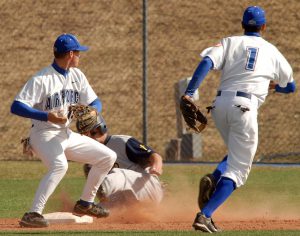
There is 1 out in the inning and a runner already on 1st base.
The pitch is delivered and the batter hits a sharp ground ball to the 2nd baseman.
The 2nd baseman quickly throws the ball to the short stop who is covering 2nd base and touches the bag before the runner coming from 1st. That’s out #1.
The short stop immediately throws the ball to the 1st baseman who touches 1st base before the runner coming from home. That’s out #2.
The defense has completed what is called a 4-6-3 double play!
Since there was already 1 out in the inning, the second out of the double play stops action.
If the runner coming from home had been able to beat the throw from the short stop, the runner could still have attempted further action.
What Is An Out In Baseball?: Wrap It Up!
Think of outs as failed chances.
Each time a batter comes to the plate, they have a chance to complete a positive action for their team.
If they are caught attempting to complete an action, then they are “OUT!”
Remember that each team has as many chances as they want, but each team only gets 3 failed chances in their offensive half of each inning.
3 failed chances = 3 outs.
I hope this article answers the question – What is an out in baseball?
If you have any questions about this article or anything else, please leave a comment below and I will get back with you right away.
Thanks for stopping by ~Jeremy
